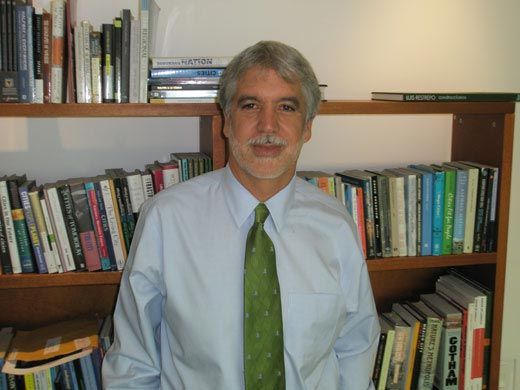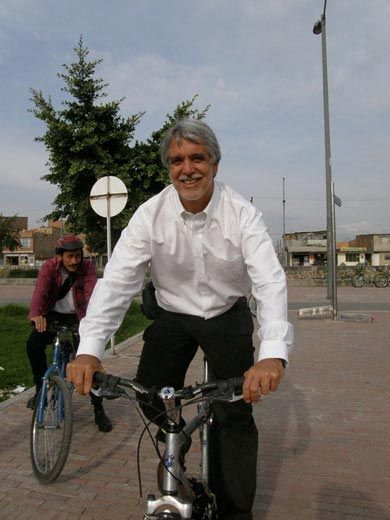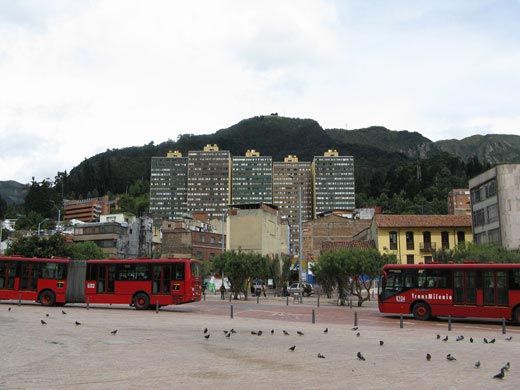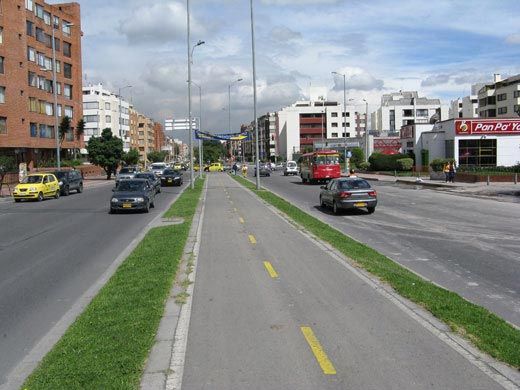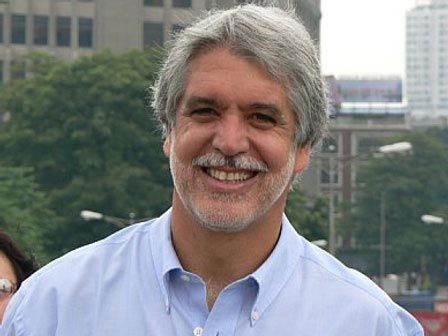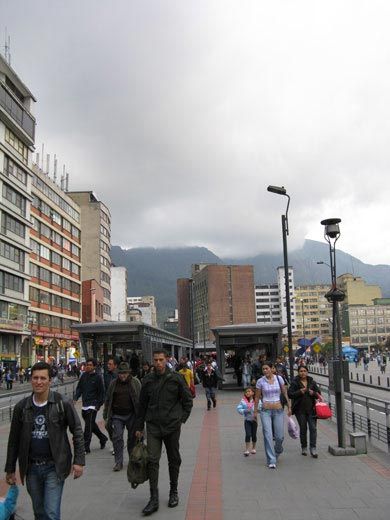Colombia Dispatch 11: Former Bogota mayor Enrique Peñalosa
The former mayor of Colombia’s capital city transformed Bogota with ‘green’ innovations that employed the poor and helped the environment
/https://tf-cmsv2-smithsonianmag-media.s3.amazonaws.com/filer/penalosa_631.jpg)
Enrique Peñalosa's controversial work as mayor of Bogota, Colombia's capital, from 1998 to 2001 has made it an unlikely model for cities worldwide. The city of about 7 million inhabitants lies in a nearly constant gray chill at around 8,600 feet in elevation. The north is full of luxury apartments, modern shopping malls and efficient highways, but Bogota is also a magnet for the poor and refugees. There are vast slums of dirt roads and shanties and a conspicuous homeless population in the heart of downtown. Peñalosa says he worked hard to change inequalities through reforms that cracked down on cars and benefited pedestrians and the poor.
"We tried to make the city for the most vulnerable people," he says. "We made Bogota more egalitarian, a happier city, a city that is more fun, a city where people prefer to be outside."
Peñalosa, who succeeded two other reform-minded mayors, opened hundreds of parks and miles of bicycle-only roads. He focused on improving the city's slums and public schools. The rapid-transit bus system he started, Transmilenio, works like an above-ground subway with red buses that zip by in dedicated lanes to passenger platforms. Peñalosa, who lived in the United States for seven years and graduated from Duke University with a BA in economics and history, now travels around the world as a consultant to city planners.
"I think that in the 20th century we made a big mistake," he says. "We built habitats much more for cars than for humans. So now all over the world we are realizing that we made a mistake."
He was working in South Africa when I was in Bogota, but spoke at length with me over the phone after he returned.
What challenges was Bogota facing 10 or 15 years ago?
Bogota was a city without any self-esteem. People thought the city was horrible and things would only get worse. The city had been made for the upper-middle classes with cars with total disregard for the 85 percent or 95 percent of the people who walk or take public transport. Practically half of the city was slums. We applied a totally different model of city. The guiding principal for us was to try to construct more equality and quality of life. Equality is a very difficult thing to do.
You mean giving the same opportunities to the poor as the rich?
Not just that. There are two kinds of equality. One is the equality of quality of life for children. All children should be able to have music lessons or sports fields or access to green spaces without having to be members of a country club. The other one, which is more important, is that public good prevails over private interest. If so, public transport should have a priority in the use of road space over private cars.
In Bogota, the real division is between those who have a car and those who don't. Those who have a car are the upper middle classes. They don't need anything from the government except police and roads. They don't use public hospitals or public schools. They don't go to parks. They jump from private space to private space in capsules called cars. They go out from their parking lot to the parking lot at the office to their parking lot at the shopping mall to the parking lot at the country club. They can go for months without walking for one block in the city.
So the real conflict in a developing country city is whether to invest money in bigger roads and bigger highways or in the many other things that people need, such as schools, parks, sidewalks, nurseries, hospitals, housing projects and so on.
What were your first steps in Bogota?
We restricted car use in many ways. Here anything that you do in order to increase pedestrian space constructs equality. It's a powerful symbol, showing that citizens who walk are equally important to those who have a car. We took out tens of thousands of cars that used to park illegally on the sidewalks. We also established a restriction that means each car has to be off the street during rush hour two days a week, three hours in the morning and three hours in the afternoon, based on their license plate number. We also increased gasoline taxes. The first Thursday of every February we have a car-free day in the city, with buses and taxis still running.
We found that 99.9 percent of the population goes to work and study as usual and 90 percent of the people have shorter travel times. People learn that they can live without a car. During the car-free days the lower-income people could not believe their eyes, that it was possible to get the rich people to take the bus next to them. It creates a more integrated society.
We started to build a lot of pedestrian infrastructure. Sidewalks are the most important. We created many bicycle paths where cyclists were protected from traffic. This is an extremely powerful symbol for equality because it shows that a citizen in a $30 bicycle is equally important to one in a $30,000 car.
When I started my term we received a Japanese transportation study that recommended $15 billion in highways. We discarded these proposals and built a 23 kilometer pedestrian and bicycle-only street through some of the poorest neighborhoods in the southwest of the city, the Porvenir Promenade. It goes across neighborhoods that don't even have pavement in the streets for cars.
The main street of downtown Bogota, Jimenez Avenue, was turned it into a pedestrian street. We made a huge effort to build parks. We think that public space is tremendously important. Public pedestrian space is really the only piece of the planet that is offered to you. In the city you have private property and then you have spaces for cars. If you go into either one you will be killed.
You may think that pedestrian space is frivolous in a city with many poverty problems, but it's actually the contrary. During leisure time there is a huge difference between the rich and the poor. The upper-income person goes to a large house, to a garden, to a country club, on vacations.
The lower-income person lives in an extremely small house or apartment. The only leisure alternative to television is public space. It's the very least a democratic society should offer its citizens. We invested a huge amount of money in parks, we built or rebuilt more than 1,000 parks. We invested in slum improvement. We brought water and sewers everywhere.
The center of downtown had been totally invaded by vendors. It was an extremely dangerous area. It was a symbol of impotence of government in the heart of the city. So we took them out, it was very difficult work.
We had the most horrendous drug dealing area in the world, the highest crime in the planet was two blocks from the presidential palace. We demolished more than 600 buildings; it was a war. We were able to open up a 23-acre park two blocks away where the biggest mafias used to be. Of course we had a huge problem rehabilitating the drug addicts. At one point we had more than 1,500 former drug addicts who had gone through rehabilitation working as city contractors.
We created a bus transit system, Transmilenio. We have had more than 450 visits from more than 70 countries to see Transmilenio. Transmilenio today is the best bus system in the world, and 20 percent of its users are car owners, extremely rare in a developing country. Transmilenio is much faster than cars.
Is the main advantage over a subway or metro system lower cost?
Yes. A subway costs 10 times more per kilometer. But you can even go faster than a subway with express buses, because subways have to stop at every station.
Now the new mayor is talking about building a subway. In a city that has so much poverty, where around 15 to 20 percent of the streets still don't have pavement, the children have to walk in the mud to school, how can you invest $3 billion dollars on a subway when you can do with a $300 million Transmilenio. Of course a subway is great, but here in this context it's not.
Was education also part of your plan?
We actually invested more in education than everything else together. We did some beautiful nurseries in the poorest areas of the city for children under five. We built 23 new beautiful schools like the most luxurious high-income schools in the poorest neighborhoods. We built fantastic libraries, three big libraries and 11 smaller ones now being used by 400,000 people every month.
What was the biggest problem you faced?
The most difficult thing was actually getting the cars off the sidewalk. But we constantly had fights. Why do we have battles? Is it just because we are crazy people who like to fight? No. If you want to really construct equality and not just talk about it, if you really want change, there has to be conflict. Some people are benefited by the status quo, and if you want to change the status quo people will complain.
Politicians like the last mayor, he just came here and said he wanted to give free food to the poor, no conflict with anybody. But that's not constructing equality. When I build a fantastic library next to a poor neighborhood, I am telling them that I believe in their intelligence and their capacity. I am constructing equality. When I give away free food, regardless of how much it is needed, I am destroying equality.
I am saying that if you are not even able to cook your own food, you are not even capable. Sometimes you have to do it and all the free food that you give to the elderly and to the children, that's fine. But once you give free food to working-age adults you are telling them they are inferior.
Do you think these ideas could be used in other cities?
Basically any city in the world could be a little more humane. Clearly the American suburban model is one that is totally nonsustainable. It consumes extremely high amounts of energy and it creates a very boring environment where there are no people in the streets and children are dependent on the soccer moms to take them everywhere. But the Americans are so amazingly efficient, I am sure that the transformation that is happening in the United States is going to be amazing.
My dream is that we can influence the development of new Asian cities. Latin America grew from the 1960s to 2000 and went from something like 30 percent to 80 percent urban. Now the same thing is happening in Asia. We can learn by our successes and errors. For example, it would be very easy to incorporate in new cities a whole network of hundreds of kilometers of pedestrian and bicycle streets. It would cost almost nothing and would totally change your way of life.
You have been in Bogota, it's a disaster. We have acquired a reputation because we have made a few interesting experiments. But our city does not have enough parks. Children are not safe in the streets. We don't have enough playgrounds. Every child here in the city plays soccer and we don't have any public soccer fields. A synthetic turf soccer field in a low-income neighborhood is more effective in reducing crime than a police station. Since I left, there have been practically no new bike paths built. It is very sad. But we realized that in the 20th century we made big mistakes and I think that in many youngsters in Bogota a seed was planted.
Planning Your Next Trip?
Explore great travel deals
Smithsonian magazine participates in affiliate link advertising programs. If you purchase an item through these links, we receive a commission.
